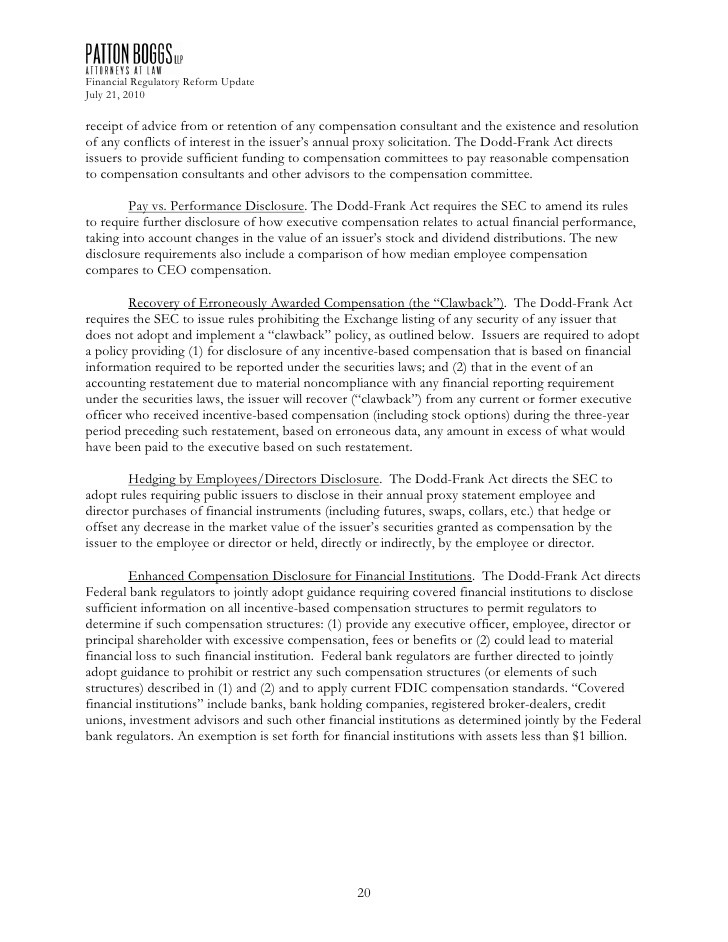DoddFrank Reform Act Elimination of Rating Agencies Protections and Implications for Bond Issuers
Post on: 16 Март, 2015 No Comment

By Erika Weinberg
The Dodd-Frank Wall Street Reform and Consumer Protection Act1 (“Dodd-Frank”) repealed Rule 436(g) promulgated under the Securities Act of 1933, as amended (the “Securities Act”), thereby eliminating the exemption from the expert consent and liability provisions under the Securities Act for any credit ratings issued by a “nationally recognized statistical rating organization” (an “NRSRO”). As a result, bond issuers that wish to include – or in the case of issuers of publicly-registered asset-backed securities (“ABS”), that are required to include – ratings information in registration statements/prospectuses (either expressly or by incorporating disclosure in the issuer’s Annual Report on Form 10-K or Quarterly Report on Form 10-Q) will be required to obtain the consent of those rating agencies. Thus far, the four largest rating agencies have publicly stated that they will not provide such consent.2 Dodd-Frank also eliminates the provision of Regulation FD that protected communications between issuers and rating agencies from the disclosure requirements of Regulation FD.3 These changes will affect registered offerings of debt securities, as well as how issuers interact with rating agencies going forward.
To read the full July 2010 issue of Finance Digest. please click here .
Rule 436(g)
Former Rule 436(g) promulgated under the Securities Act provided that a credit rating assigned to a class of debt securities, convertible debt securities or preferred stock by an NRSRO would not be considered “part of a registration statement prepared or certified by a person within the meaning of Sections 7 and 11 of the [Securities] Act.”4 Section 7 provides that when certain “experts” are named as having prepared or certified “any part” of the registration statement, the registrant must file the written consent of such person with the registration statement. Section 11 imposes civil liability on specified classes of persons in the event that “any part” of the registration statement contains an untrue statement of a material fact or omits to state a material fact required to be stated therein or necessary to make the statements therein not misleading.5 The effect of former Rule 436(g) was to exclude from both Section 7 and the liability provisions of Section 11 any ratings information provided by NRSROs included in the registration statement.6 From a practical standpoint, this meant that issuers could include – and often did include – ratings information in their prospectuses and public reports without obtaining (and filing) the rating agencies’ consents.
Prior to Rule 436(g)’s enactment in 1982, the SEC, on a number of occasions, considered how to deal with rating agencies and ratings information, both from a liability and a disclosure perspective.7 The SEC has always permitted ratings disclosure, but has never required it (except in the case of issuers of publicly-registered ABS).8 The discussion of the appropriateness of imposing Section 11 liability on NRSROs was tabled until 1994 when the SEC again issued a concept release discussing, among other things, whether Rule 436(g) was appropriate.9 The most recent discussion of the possibility of repealing Rule 436(g) was described in SEC’s 2009 Concept Release.
Dodd-Frank’s Repeal of Rule 436(g)
Section 939(g) of Dodd-Frank rescinded Rule 436(g). This section of Dodd-Frank is self-implementing and is now fully effective. There are several ramifications to this repeal that are very important for industry participants and practitioners.
Non-ABS Issuers
The practical result of the repeal of Rule 436(g) is that non-ABS issuers that elect to include credit ratings issued by a rating agency (whether or not an NRSRO) in its registration statement/prospectus must first obtain and file the consent of the rating agencies whose ratings are included. The four largest rating agencies have already indicated that they will not be providing any consents (for now, at least).10 As a result, issuers and underwriters are now precluded from engaging in the historic market practice of including ratings in registration statements/prospectuses. The inclusion of ratings information in pricing term sheets or free writing prospectuses is still permitted by the SEC.11 It has also been common practice for investment grade issuers to include ratings information in their annual reports on Form 10-K or quarterly reports on Form 10-Q. Absent guidance from the SEC, the repeal of Rule 436(g) may have been interpreted to require an issuer that included ratings information in its periodic reports to remove the otherwise incorporated ratings information in order to avoid having to obtain a rating agency’s consent.
In response to these and other uncertainties related to the effect of Dodd-Frank’s repeal of Section 436(g), the Staff of the SEC issued new Compliance & Disclosure Interpretations on July 22, 2010 relating to the need to obtain rating agency consents for issuers of corporate debt securities:
- For registration statements declared effective on or before July 22, 2010 that include more than “issuer disclosure-related ratings information,”12 the SEC would not require consent of the rating agencies until the next post-effective amendment to or supplement of such registration statement13 (e.g.. the issuer’s next Form 10-K filing) so long as no subsequently filed periodic report that is incorporated by reference into a registration statement includes more than “issuer disclosure-related ratings information.”
- As such, no amendments to already filed periodic reports are necessary.
- For registration statements declared effective after July 22, 2010 that include more than “issuer disclosure-related ratings information,” a consent will be required.

The repeal of Rule 436(g) had immediate consequences for issuers of asset-backed securities.14 This resulted from the intersection between the repeal of Rule 436(g) and existing disclosure requirements for public issuances of ABS set forth in Regulation AB.15 Regulation AB currently requires an issuer of publicly-registered ABS to disclose in its registration statement the minimum credit rating that must be assigned to such ABS, as well as the identity of each rating agency providing such rating to the extent the issuance or sale of any such class of ABS being offered is conditioned on the assignment of such minimum credit rating.16 Given the repeal of Rule 436(g) and the statement by a majority of the rating agencies that they would not be providing consent to the inclusion of ratings information in registration statements, ABS issuers found themselves in the unfortunate situation where, directly as a result of the repeal of Rule 436(g), they were unable to bring publicly-registered ABS deals to market.17 The SEC acted swiftly through the issuance of a no-action letter which allowed issuers of publicly-registered ABS to omit credit ratings from registration statements filed under Regulation AB.18 The SEC noted that this relief, which extends until January 24, 2011, is to “facilitate a transition for asset-backed issuers” following the repeal of Rule 436(g). In a recent statement, the American Securitization Forum noted its current understanding that Congress intends to work on a “correction bill” to address the issues raised by the repeal of Rule 436(g) for ABS issuers subject to Regulation AB.19
Revision of Regulation FD
Regulation FD governs the selective disclosure of material non-public information by issuers with a class of securities registered under Section 12 of the Securities Exchange Act of 1934, as amended (the “Exchange Act”), or that are required to file reports under Section 15(d) of the Exchange Act.20 Regulation FD requires that unless an exemption applies, an issuer must publicly disclose any such information selectively disclosed to any person described in the Rule. Rule 100(b)(2)(iii) currently provides an exemption for information delivered to an entity whose “primary business is the issuance of credit ratings, provided that the information is disclosed solely for the purpose of developing a credit rating and the entity’s ratings are publicly available.” Section 939B of Dodd-Frank requires the SEC, within 90 days of the enactment of Dodd-Frank, to revise Regulation FD to delete Rule 100(b)(2)(iii). It is unlikely that the deletion of this exemption will have any practical impact on an issuer’s ability to share information with rating agencies during the process of obtaining a credit rating for two reasons.
First, a rating agency is not the type of “person” to whom disclosure is prohibited under Regulation FD. Rule 100 of Regulation FD provides that disclosure to the following “persons” is covered by the Rule: “any person outside the issuer: (i) who is a broker or a dealer, or a person associated with a broker or a dealer, as those terms are defined in Section 3(a) of the Securities Exchange Act of 1934; (ii) who is (A) an investment adviser, as that term is defined in Section 202(a)(11) of the Investment Advisers Act of 1940; (B) an institutional investment manager. (C) a person associated with either of the foregoing;. (iii) who is an investment company. ; or (iv) who is a holder of the issuer’s securities, under circumstances under which it is reasonably foreseeable that the person will purchase or sell the issuer’s securities on the basis of the information.” Historically, there was some thought that a rating agency was an “investment adviser” and as such disclosure to a rating agency would be covered by the ambit of the rule. This is no longer the case,21 and therefore, a rating agency would not fall within the type of “person” to whom disclosure is prohibited. Secondly, if the rating agencies agree (in a confidentiality agreement or a confidentiality section of their engagement letter) to maintain the disclosed information in confidence, then the communication would likely fall within the ambit of Rule 100(b)(2)(ii).22 We expect that the rating agencies will work with issuers to create some form of confidentiality arrangement going forward.23














